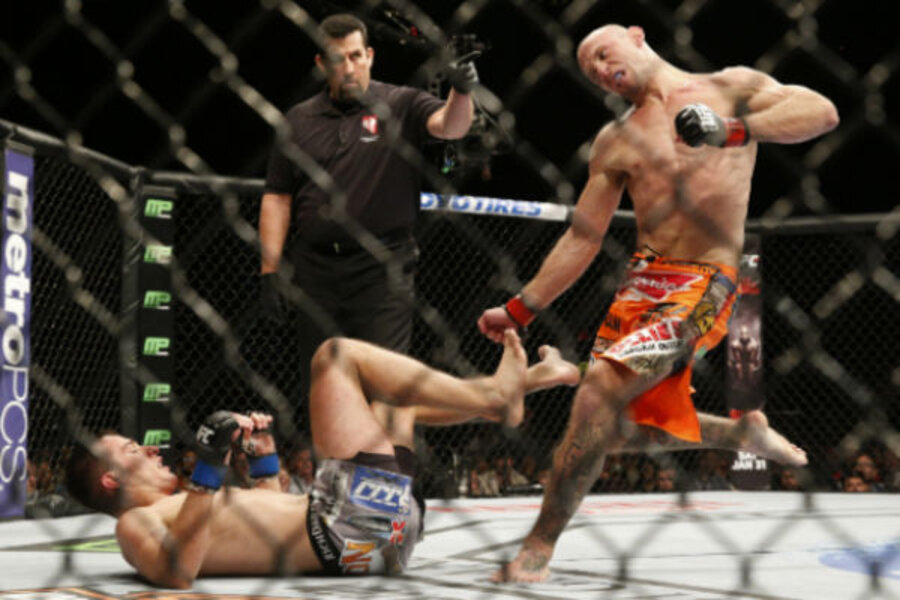Chokehold on the playground: How much has roughhousing changed?
Loading...
As violent episodes get more airtime in the news, cartoon- and video-game violence continues to be a presence, parents may need to think about how to counter the negative effects of what kids watch before a chokehold makes its way into schoolyard playtime.
As many still grapple with the ripple effects of the death of Eric Garner, placed in a fatal chokehold by police officers, we might forget about what kids can inadvertently learn from footage of his arrest that ran on repeat through weeks around his death and the subsequent trial of the officers in question. A simple, old-school game of cops and robbers can take a very different path if some of these impressions are left unchecked.
One expert from the Child Mind Institute in New York has advice on how to institute “mediated viewing” and positive behavior modeling as a counter measure.
“We are often asked by parents and teachers how what kind of consequences there should be for behaviors kids imitate or learn through watching TV or playing violent video games,” says Dr. David Anderson, senior director for the ADHD and Disruptive Behavior unit at the Child Mind Institute in New York City. “I prefer to address what is being done to model positive behaviors, what positive references can come from what they are seeing, and helping them to see what the right reactions look like.”
Rather than talk about punishments, Anderson suggests talking with the child about what the child could have done differently to manage his or her frustration in the moments that led to the violence.
“We need to avoid common parenting traps and instead have discussions with children about when certain behaviors are appropriate or should not be done at all,” he says in a phone interview. “What we really need to focus on is watching what they watch with them – mediated viewing. Being present to see what is happening in the games, not to just say ‘Shut that off’ but to talk about what they are seeing happen.”
According to Anderson, “Play and a child’s reactions to conflict evolves and is informed by what kids see on TV and video games. As an example, when they see karate, you can help them see that comes alongside values such as self-discipline, self-defense. There are times these moves may indeed be appropriate. That’s why we also have to watch and monitor their play, so we can see how this is impacting.”
I personally became interested in dealing with this issue last Friday after receiving a phone call from the counselor at the elementary school my son attends.
The counselor, a dedicated professional, told me that my son, “had been playing Cops and Robbers at recess with a group of other boys.”
According to her account, when the other boy apparently kept letting robbers out of jail, my son Quin offered to switch assignments. The other boy became upset and started choking Quin. She added, “But he’s alright. He wasn’t hurt. It was probably more of a boys-will-be-boys kind of thing.”
A sharp-eyed teacher pulled the boy off of my son.
I tried to picture the scenario wherein “choking” someone could be laughed-off. I pictured the Simpsons cartoon and dad Homer face to face with son Bart choking him. Maybe it was something like that.
However, when Quin got home, and he gave a more detailed account of how the other boy had been behind him, and what he described sounded what is considered a "Rear Naked Choke," in martial arts. I am not sure if this was what the boy was attempting, or where he might have learned it, but the hold seemed eerily similar to the chokehold broadcasted repeatedly in recent months following Garner’s death.
Some might say that my son was being dramatic, a reality understood by many parents of kids, but even in its most innocent usage, a chokehold is not simple roughhousing.
A chokehold to cut off air, or in the case of the Rear Naked Choke – to cut off oxygen to the brain, is not child’s play, and can be deadly. Part of the inherent danger of choking from behind is that you can’t see the face of the person you’re choking to know if they are in distress.
While I can’t get a video replay of what actually happened and have only my son’s account of the incident, what I can say for certain is that I called the counselor back and told her that she and other educators need to be aware of the danger of this move being performed by a child.
I sent the counselor a link to a video by martial artists Rener and Ryron Gracie of California, titled “Boy Chokes His Cousin to Death with Rear Naked Choke.”
The Gracies are pretty much my go-to people when it comes to bullying and school violence solutions since their Bullyproof seminars and videos for kids and parents have been a great help to my kids for the past five years.
This video was made back in April 2012 after a Louisiana man was choked to death by his younger cousin while playfully sparring at home.
The counselor, I'm told, went back to teachers and spread the word about the gravity of this kind of play.
Recess and play time are important parts of childhood as well as incubators for future social behavior. This is an opportunity not just to watch TV or video games beside my son in order to monitor what he watches, but a chance to go out and play with him and in so doing, model the best behaviors. Then hopefully I can preserve his fun and safety while we build new experiences together.








